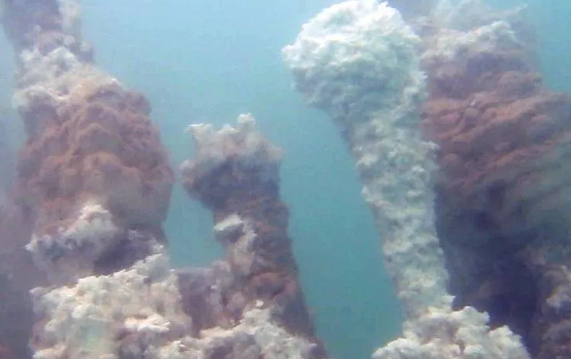Unique Mineral Chimneys Discovered in the Dead Sea Floor
Researchers have discovered unique mineral chimneys on the Dead Sea floor, which are a result of highly salty groundwater. The findings were published in Science of the Total Environment. This discovery may help predict dangerous sinkholes in the region.
Characteristics of the Chimneys
The chimneys can reach heights of up to 7 meters, that can grow several centimeters daily. Their widths range from 2 to 3 meters. The structures resemble ocean floor smokers, but they emit salty fluids instead of hot water.
Formation Process
Chimneys form when salty groundwater rises from below. This water mixes with the Dead Sea’s brine. The dissolved salts, mainly halite, crystallize rapidly. The process creates the chimney-like structures observed.
Environmental Context
The Dead Sea has been shrinking for over 50 years. It loses approximately 1 meter of water annually. Reduced river inflow and high evaporation rates contribute to this decline. The current surface level is about 438 meters below sea level.
Impact on Surrounding Areas
Falling groundwater levels affect Israel, Jordan, and the Palestinian territories. Access to groundwater has become increasingly difficult for these regions. The shrinking Dead Sea exacerbates these challenges.
Sinkhole Risks
Sinkholes are large craters that form when salt layers dissolve. Thousands have appeared around the Dead Sea, some reaching widths of 100 meters. They pose risks to lives, agriculture, and infrastructure. The chimneys can indicate areas prone to sinkhole formation.
Future Research Directions
Scientists recommend using autonomous watercraft with sonar systems. These tools can map the chimneys effectively. Identifying vulnerable regions may enhance sinkhole prediction and management. This research provides hope for better understanding this dynamic environment.
Important Facts for Exams:
- UFZ: The Helmholtz Centre for Environmental Research is based in Germany. It conducts interdisciplinary research on environmental issues. Its findings aim to support sustainable development and environmental protection.
- Halite: Halite is a mineral form of sodium chloride. It commonly occurs in evaporite deposits. Halite is essential for various industrial applications including food preservation and chemical production.
- Sinkholes: Sinkholes are depressions caused by the dissolution of soluble bedrock. They can occur suddenly and unpredictably. Their formation poses important risks to infrastructure and human safety in affected areas.
- Brine: Brine is highly concentrated saltwater. It forms when seawater evaporates or when groundwater dissolves salts. Brine is used in various industries including food processing and chemical manufacturing.
Month: Current Affairs - November, 2024
Category: Environment Current Affairs


